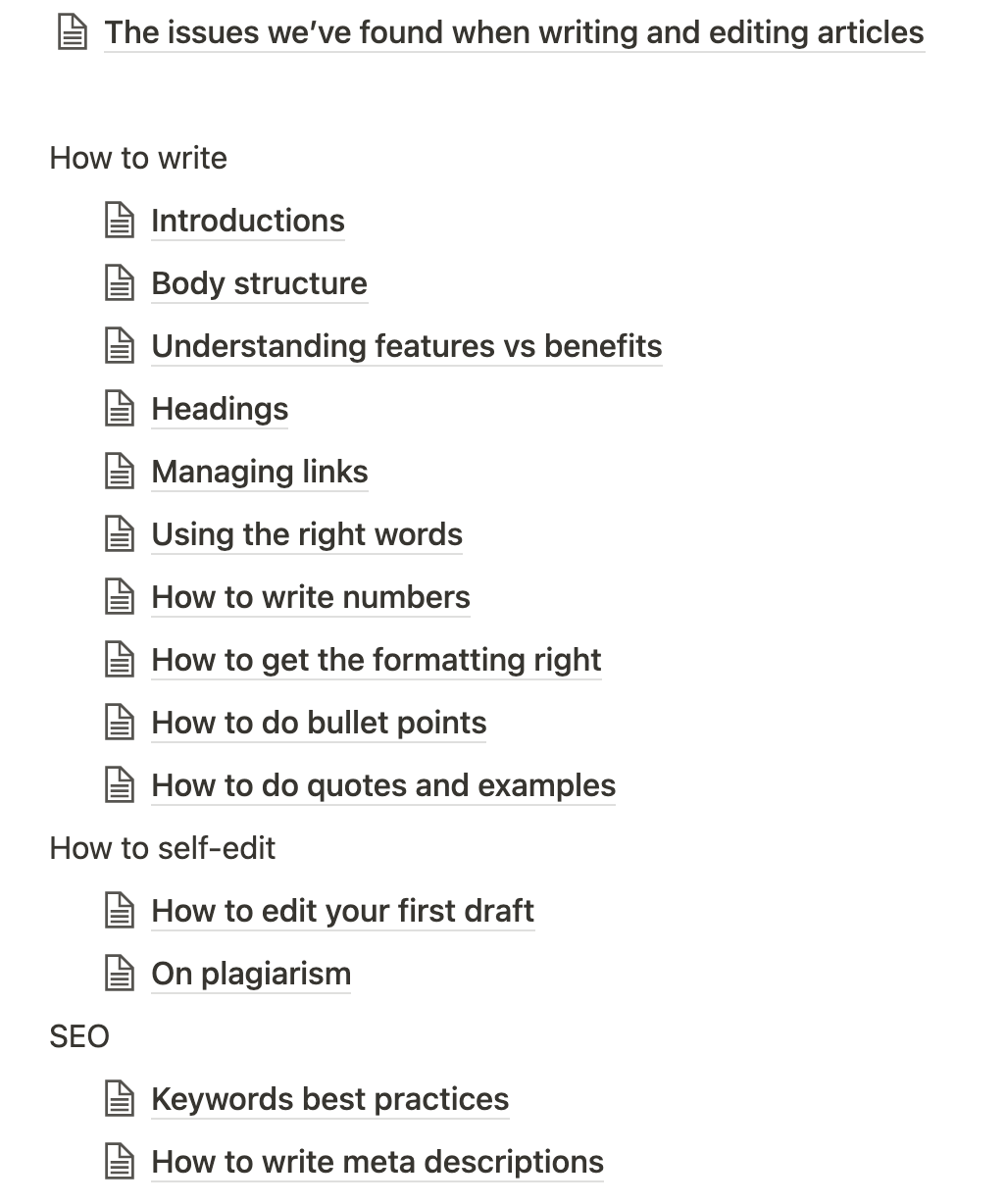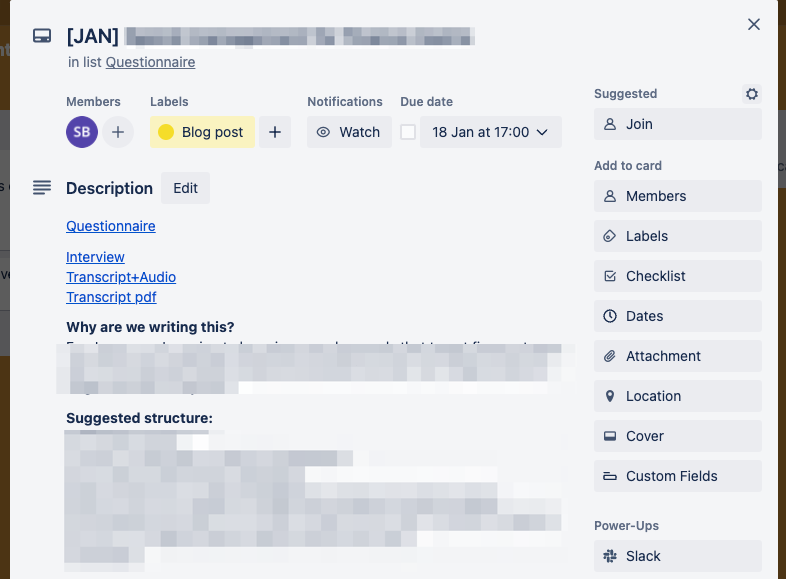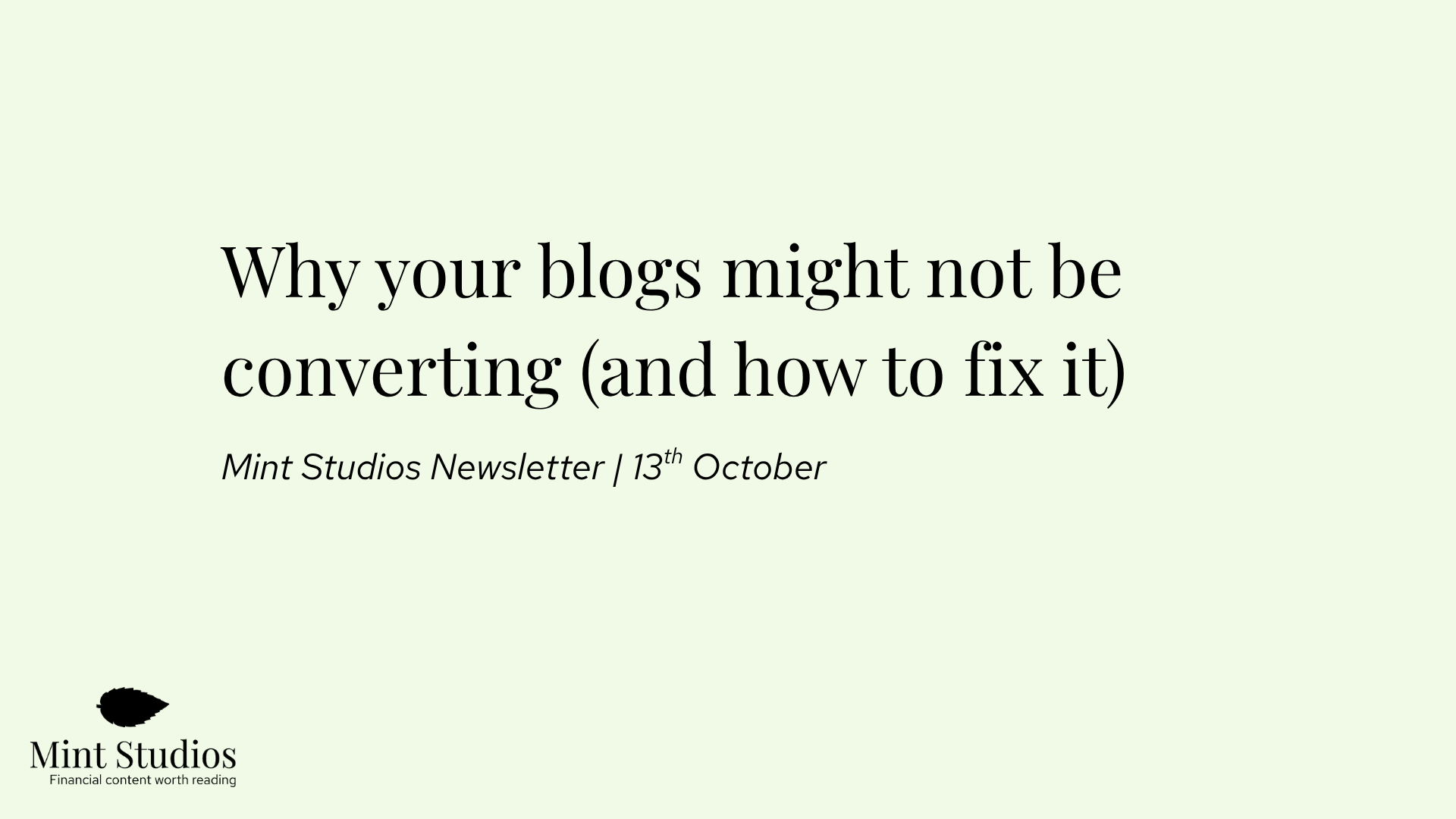To many in the content marketing space, content briefs are an indispensable part of content marketing.
They act as the intermediary between the strategist and the writer. They help avoid back and forths. They keep the writer on track. Supposedly, they give the writer everything they need to write a stellar article.
In this article, we want to argue why content briefs aren’t as useful as they may look, and why we suggest throwing them out altogether.
The truth is that at Mint Studios we used to do content briefs, and pretty much everyone on the team has received and produced them at one point in time. But we’ve also created in-depth, detailed and engaging content that brings in leads effectively. And guess what: these were done without content briefs.
What if we told you: the content brief is actually what’s standing in the way of creating great content that brings in customers.
Let’s dive in.
Why most content briefs are a step in the wrong direction
We don’t use content briefs at Mint Studios. Instead we use an alternative, inspired by Grow and Convert: the questionnaire.
But before we go into how we do things, we want to highlight the reasons why we don’t believe the content brief is the best way to create great content that helps bring in customers.
It encourages the writer to focus on the wrong things
This is the main reason we don’t like the content brief. As per the screenshot, the content brief usually includes items like:
- Who the article is targeting
- The topic/title
- Main points to touch on
- Keywords to target
- Word count
- Style guide

That’s just the tip of the iceberg. Some content briefs are five pages long! They’ll include details on how to write bullet points, where the writer should do their research, what links to include, and so much more.
Everything except what is most important: the message we’re trying to share.
Anyone who reads a lot of business writing online knows that grammar and syntax isn’t what makes an article or piece of business writing great.
People spend hours reading Reddit posts where grammar and syntax goes out the window. We’re all a lot more compelled to read these types of posts than another boring article that might be grammar-perfect, but is about “digital transformation in 2023”.
And that’s the main issue with content briefs: it focuses too much on what should be secondary. In fact, it’s so focused on what’s not so important, that the writer spends more time ensuring every semicolon is perfect and every sentence has perfect syntax.
That’s how you get vapid, boring articles that don’t really say anything. That don’t address a specific pain point. That have all the latest trendy words, but don’t really answer your questions.
Content briefs forces the writer to focus on the things that ultimately don’t make a piece great.
If you are using content marketing to rank on Google and acquire customers online, what matters is the message and content itself, not the grammar, syntax and the fancy words you use.
Before the grammar police come for us: we’re not saying these are not important. We’re not saying that you should write articles that have terrible grammar and that are practically unreadable.
We’re saying that in the world of digital marketing, sales copywriting and online business writing, the primary focus should be your message. Grammar and syntax come afterwards.
If the message in the article is boring, people will glaze over and won’t read it, no matter how perfect your grammar and vocabulary is.
It encourages the writer and strategist to be lazy
The second reason we’re not fans of the content brief is that it puts a lot of energy on focusing on the easy stuff: grammar, syntax and vocabulary. This becomes an excuse to not focus on the real hard stuff: whether this article adequately shares a message which resonates with the reader, matches their intent, and helps you reach company goals.
Instead of properly thinking who this article is directed to, what the pain points we are addressing and what products or features to include, we’re using meaningless words to meet the 2,000 word guideline.
That’s how you get articles that say stuff like "project management software is a tool that helps you manage projects from start to finish."
When your only guidance is “persona: product manager, topic: how payments works for marketplaces, word count: 2,000”, then you end up writing something that is recycled from Google and doesn’t really help anyone.
And that’s the other thing: we’re all tired of reading recycled Google content. Another “what is a direct debit” post or “top payment methods” post.
Content briefs enable recycled Google content because the writer isn’t forced to think too much about the message of the piece. Instead, they are asked to spend that energy on making sure their Tone of Voice is “business casual”, that they follow the structure exactly as it’s been given and that they include the keywords the right number of times.
Content briefs replace strategic writing. Before even writing the article, you need to make sure you are aligned with the writer on who you are targeting, what their pain points are, how you’re going to talk about your product. Content briefs make it far too easy to copy-paste, paraphrase and recycle other articles, white papers and blogs found online. Content briefs make people lazy.
It attempts to replace expertise
We’ve said this on Mint Studios many times before: business content writing is not writing for entertainment, or for fun. The typical “write for your grandma” or “write for a 5 year old” does not apply here – especially not in the B2B fintech world.
No one reads content about payments for pleasure, and especially not your grandma. If someone is reading content about payments, it’s because they want to get something done. So why not do exactly that? You can write direct, interesting and engaging content without using cliches like starting off an article with “When was the last time you used your card?”.
In the content marketing world, we are in the business of customer acquisition, not entertainment.
That means that the articles you write should be based on expertise. The way we do that at Mint is that each article is based on an interview with an expert.
But people who use content briefs rarely use interviews with experts. Instead, they expect that with two sentences on the persona, the product and the market, the writer should be able to fully comprehend how to structure the piece, what product details to include and what customer pain points to focus on.
It’s one of the issues we have with hiring freelance writers who don’t work with you long term. They can’t know enough about your product/market etc to write a successful piece of content. You cannot possibly understand enough about the product/market/customer based on a few sentences from a brief. So how do people overcome this?
They a) do it anyway, leading to terrible content.
OR
b) they ask the writer to write “thought leadership” content. Which is essentially them reading a few white papers and content online and summarising it. Unless you give them something to write based on a unique angle from an expert, then it is not thought leadership.
In other words, this is not thought leadership:

Thought leadership is taking a unique stance on something. And that’s not something that a freelance writer can do without having access to an expert.
Ron Shevlin from Cornerstone Advisors is very good at this.
One other solution that Dom Kent mentions is outsourcing “Top of the Funnel” content and doing anything related to the product, market and customer in-house. This works well if you have a content person in-house – but what if you don’t? Will you always be stuck doing Top of the Funnel content that will help bring you traffic but no customers? In 2023, companies can’t afford to do that.
Read more: How Many Leads Can You Generate with Content Marketing?
It leads to misalignment
A lot of freelance writers require clients to fill in a content brief to combat the “one sentence brief”. They’re using the content brief for the right reasons: to ensure they write a piece that matches the expectations of the client.
However, we believe the content brief is well-intentioned, but a step in the wrong direction.
The main argument for content briefs is to align the strategist and the writer.
But we would argue that content briefs lead to misalignment. We’ve lost count of the number of marketing managers who come to us saying “we’ve worked with an agency/freelancer before, but the articles they wrote were very generic and weren’t really what we were looking for”.
That’s because, as we’ve said above, the content brief encourages the writer to write the article without having a clear understanding of the target market, customer and product. Without access to an expert who can share unique points of view and information, it’s hard to write something original and expert-focused.
If you’re a strategist who’s reading this: how many times have you had to rewrite an article – even if you did send through a comprehensive content brief? How many times did you think “they completely missed the main point here”? How many times did you think “they don’t really know what they’re talking about”?
If you’re a writer, how many times did you get a content brief and then think: where do I even start with this? What are they trying to do with this type of article? How do I talk about the product?
Sure, part of the issue there might be that the writer or strategist is not an expert on the topic or on content strategy. But the other issue is that we actually don’t believe the content brief does not adequately tell the writer what is expected of them.
You might be able to overcome this by asking the writer to complete an outline, reviewing it, and then asking them to write (which is partially what we do). However, that won’t replace the fact that the strategist and writer need to both agree on the underlying story or message. Filling out an outline doesn’t ensure that both parties are agreeing on what the main takeaway and message is.
It encourages industrialisation of writing
A lot of writers apply to work with us because they’re tired of being treated like a robot or content mill. As a writer, you’re more than someone who can churn out 2,000 words per week on a vague, dull topic. You’re someone who can write a compelling story that will speak to someone. But it’s hard to do that when you’re on the clock for 3 blog posts per week (or more!).
Content briefs – for the better or worse – are an attempt to make content writing more efficient. Instead of working with a writer who can interview an expert and extract the main message, it encourages a strategist to do all the hard work, and then productise and outsource the writing process.
Maybe that works for Top of the Funnel content where you’re defining words and writing for beginners. But if you want to write content to acquire customers, position yourself as an expert and genuinely educate your target audience, this doesn’t work.
If there’s anything we’ve learnt over the years of writing content, it is that great writing is not meant to be productised. You cannot industrialise writing. You cannot write a piece of content designed to convert a reader into a customer, without understanding how the product works, who the customer is (and what their pain points are) and who the company is. It would be like asking to create apple juice with any apples.
The essence of writing is understanding your customer and their problems, and attempting to help them. How can you do that if you don’t understand who you’re writing for?
We dislike content briefs because they uglify and industrialise the process of writing. In a way, they productise and some may say disrespect the writer. When you write a content brief, you’re telling the writer: we don’t trust you to take the time to understand the product, and we’re not willing to pay you to take the time to understand the customer and market. Now go write a blog post.
Great writers hate briefs because it essentially turns them into writing machines. Great writers like to deeply understand a product, customer and market, and come up with a way to communicate the main message themselves.
So if content briefs are a step in the wrong direction, what can we do instead? Read on to find out.
What we use instead of content briefs: questionnaires and a focus on the message
This was inspired from Grow and Convert, who use questionnaires and walk you through their process in their course.
The goal with the questionnaire is to truly align the writer and strategist, and also train the writer on sales copywriting. Since we write content that converts readers into customers, a big part of the content we write is focused on making an article easy to read on a laptop/phone, being very clear and adequately selling a product.
To explain how the questionnaire works, we’ll walk through our writing process as a content marketing agency that specialises in helping fintech companies acquire customers with their blog:
1. Share relevant resources with the writer
Before even starting, we share as much information as necessary with the writer about the client’s company. We don’t expect the writer to understand the product, target market and company with just a few sentences on a document.
We share with them the product demos, interviews with the founders, a content strategy and more. We’re currently in the process of building out a mini wiki for each client, so we can always refer to it easily and update it whenever something new happens.
We’ll also share a document that breaks down how we write and what our style is like. This is one-off and they don’t have to read it every time they write a new article. Since the type of writing we do is a mix of sales copywriting, content writing and SEO, there is quite a bit of training that goes on (which is why we’re not a fit for everyone):

2. Add the writer to the Trello board with basic info
We use Trello to track at what stage each article is at. Each article has its own Trello card, and on there we’ll have details like:
- Link to the interview for the topic
- Explanation of why we’re writing this article
- A suggested structure

You could argue this is like a content brief, but there is a key difference. The writer won’t start writing the article yet. Instead, we want to make sure the writer really understands who they’re targeting, what the pain points are and what features and benefits to focus on.
We’ve set up the Trello in a way that offers direction, but ultimately it’s up to the writer to turn the article into a great piece. Based on all these resources we’ve shared with them, they then fill in the questionnaire.
3. The writer fills in the questionnaire
Another key part of how we work is that practically each piece of content is based on an interview with an expert. This makes it a lot easier for the writer, since they don’t have to spend hours doing research and don’t have to rely on their own expertise.
They listen to the interview, and then they fill in a questionnaire which asks them to respond to certain questions like:
- What do you think the customer is looking for when they Google this?
- What are the pain points? How does the product solve for it?
- What are the features and benefits of the product that help solve these pain points?
As you can see, we are asking the writer to fill this in themselves. We’re encouraging them to think. We’re respecting the fact that they can digest how a product works, who the target market is and how that relates to the competitive landscape.
The most important section is the last one: the product’s features and benefits. There are many articles that brag about features, but never talk about specific use cases, touch on pain points or highlight benefits (check out any Hubspot article to see what we mean).
We focus a lot on pain points and use cases because these are relatable, and effectively communicate authority and experience in what the company is doing.
Within this questionnaire, we ask the writer to write an outline, and this helps with aligning on structure. Anyone can get the headings right: it’s another thing to get the messaging within each section right. With an outline, we already know if the piece is going in the right direction and everything is correct and accurate.
All the hard work is done with the questionnaire, supposedly making the first draft a lot easier to do. It also means that the writer understands who we’re targeting, what features to write about and a lot more before writing the first draft.
4. The strategist reviews the questionnaire
At this point, the strategist then reviews the questionnaire. The strategist is someone who knows the client and the product inside out, so they can easily add some extra information, share some input about the structure, and suggest case studies. They also conduct the interviews, so might have a better feel for what the client is looking for.
Once the strategist has reviewed the questionnaire, they can be sure that they are aligned with the writer on messaging and structure. But most importantly, on messaging.
5. The writer completes the first draft
Only now do we write the first draft: when both people are (hopefully) aligned. The writer clearly understands who to target, what product features to include and the pain points. They now have all the tools ready before writing.
Writing the first draft is a lot easier, because everything has been written down and there is an outline ready.
6. Review of first draft
The strategist reviews the first draft and adds any comments on structure, etc. There shouldn’t be any large changes here, since everything has been taken care of in the questionnaire phase. But just in case, there is a review phase here.
7. Second draft
For seasoned writers who have been with us for a while, there is very little editing that happens with the second draft. But if it’s a new writer who still needs training, then they might have to implement the comments from the first draft.
8. Final pass, SEO checks, submission to client
Only now is the article ready. The strategist might add some links, add any SEO related stuff (meta description, etc), pass it through Grammarly and make sure it reads well. With that, the client will review to make sure there aren’t any mistakes when it comes to describing the product. Once the client reviews, then we publish.
Many agencies are an SEO content farm: the brief dictates where they mention keywords, how many times to use it, etc. At Mint, we intentionally write the article for the buyer before even thinking about SEO. We make sure the logic is in place, the right features and benefits are included and that the examples make sense.
Some of the articles we create are not optimised, and they still rank on Google. In fact, some of our least “SEO’d” pieces rank on Google and bring in the highest number of leads for our client. Because we’re focusing on the message, not on hitting an arbitrary word count.
We’re not saying our approach is perfect – we’re continuously iterating, improving and looking for ways to smooth out the process.
However, so far the result is:
- The writer only writes the article once they are sure they understand the key pain points, the key product features we want to talk about and the why behind the article.
- The strategist and writer are definitely aligned before publishing.
- The ultimate goal of the article is to make sure the message makes sense, that the pain points are well transmitted and that the key message comes across.
- Instead of focusing on grammar and syntax, we’re focusing on:
- Does this match the reader’s expectations when they do research
- Does this answer their question?
- Does this educate the reader on the product, and make it easy for them to convert if they’re interested?
- Are we sure we’re explaining the product correctly and highlighting the features and benefits?
Writing great content is hard
You might have read this and thought “wow, that’s a lot of work”. And that’s because great content is not easy to create.
You cannot write great content that speaks to the readers’ pain points, includes the right product features and shares unique insights in an hour.
At Mint, it takes us about two weeks to create an article, and that’s only a part of what we do. We also conduct all the interviews with experts, create the content strategy, report on results every month and ensure that the content we’re publishing helps meet the client’s goals.
We don’t create content because it’s easy, we create content because we fundamentally believe it can help grow a company when done well.
Content briefs are well-intentioned – but a step in the wrong direction
So, are content briefs the spawn of Satan? Content briefs are perhaps not the spawn of Satan, but instead simply a step in the wrong direction. The writer and strategist are acknowledging the need to align – it’s just that the content brief might not be the best vehicle to do so. Not if you want to create content that brings in customers and establishes your company as an expert.
Instead of using a brief, we would encourage the writer to conduct an interview with the expert, learn as much as they can about the product and aim to work with clients long term. It benefits the writer, the company and the reader.
There is no replacement for understanding the customer, empathising with the pain points and figuring out what type of information they want. You cannot outsource that, you cannot productise it either. Content briefs are a shortcut, and they nearly always lead to vapid, boring, unengaging content.
To illustrate our point even further, here are two articles on the same topic (3DS2):
This is an article written via content brief: 3DS2: What it is, when it comes into force, and its impact in Spain
This is one created with our questionnaire method: 3DS2: Everything you need to know and how to prepare for it
Guess which one was written with a regular content brief, and which one was written with our questionnaire method. You likely guessed right.
If you truly want to create great content and want content to play a large part of your marketing mix, get rid of content briefs and work with writers who want to understand your product, market and company and want to help you use content to grow (especially in 2023, when the focus is on ROI). If you’re not doing that, then you’re throwing money down the drain.











